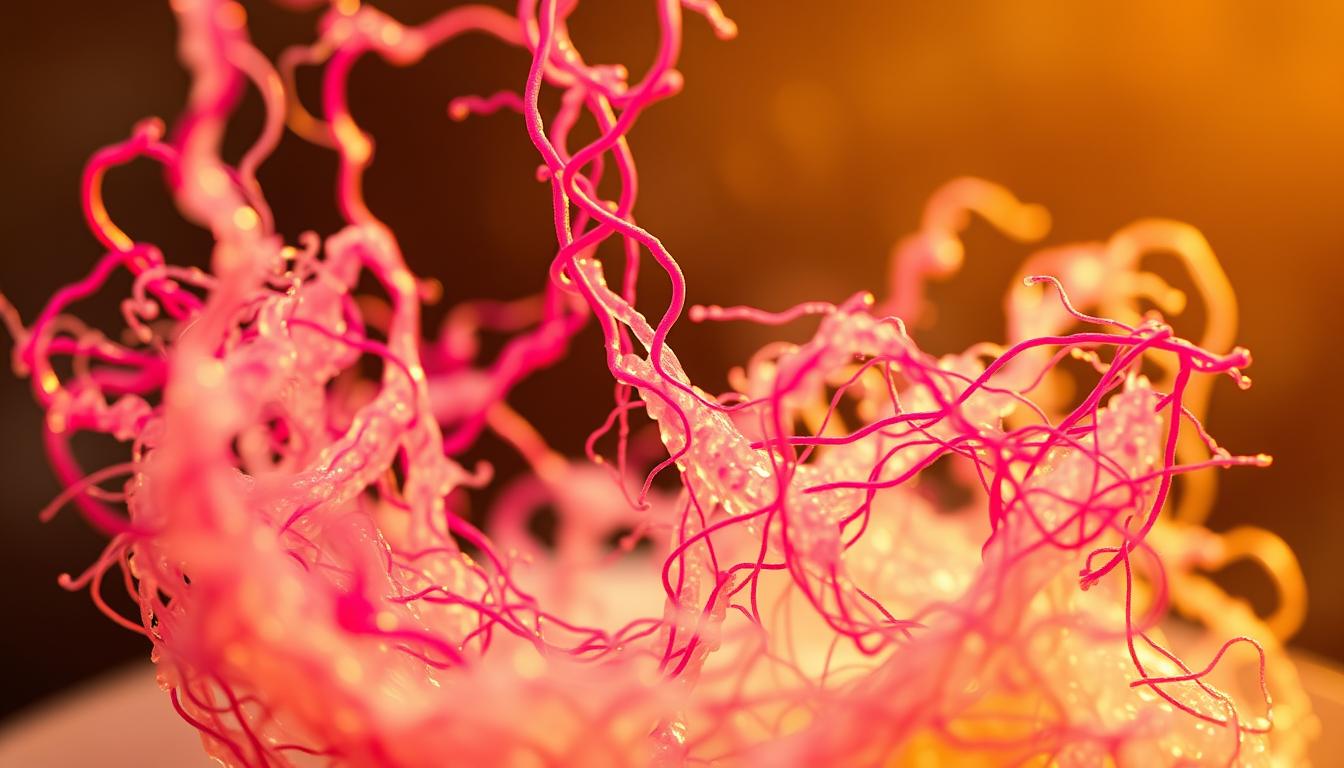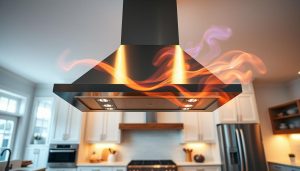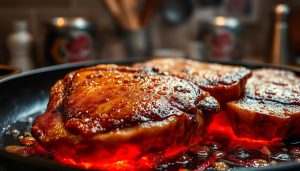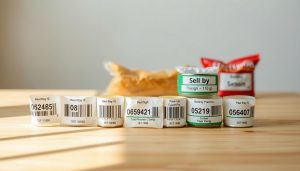Did you know that a 40°F temperature shift can turn velvety scrambled eggs into a rubbery disaster? This dramatic transformation happens through molecular restructuring occurring between 140-180°F (60-80°C), where invisible strands in ingredients reorganize to create entirely new textures.
When exposed to heat, acid, or salt, natural structures in ingredients unwind and reconnect. Imagine unraveling a ball of yarn, then weaving it into a net—this exact process determines whether your custard stays silky or becomes grainy. Ancient cheesemakers used this principle instinctively, while modern chefs apply it deliberately for precision results.
Mastering this phenomenon lets you predict outcomes across cooking methods. Gentle heat coaxes dairy into creamy sauces, while intense temperatures forge steak’s firmness. Even plant-based alternatives rely on similar principles to mimic animal-derived textures.
Key Takeaways
- Heat, acid, and salt trigger molecular bonds that reshape ingredients
- Optimal temperature ranges prevent undesirable rubbery textures
- Visual cues like curd formation indicate critical texture changes
- Historical food preservation methods relied on these reactions
- Texture control separates amateur attempts from professional results
Understanding the Science Behind Protein Coagulation
Every culinary masterpiece begins at the molecular level. Amino acids—twenty unique building blocks—combine like puzzle pieces to form complex chains. These chains fold into specific shapes that define their behavior when exposed to external forces.
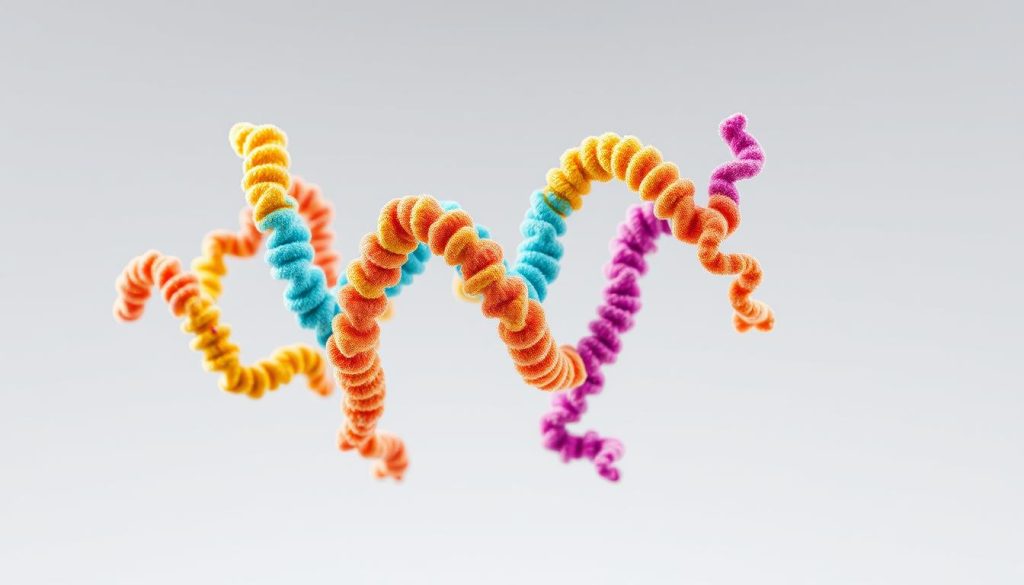
Denaturation versus Coagulation: The Molecular Transformation
Denaturation acts like a molecular reset button. When you apply heat or acid, tightly wound strands unravel. Imagine zippers splitting apart—this exposes hidden connection points along the amino acid chains.
Coagulation steps in next. The loosened strands interlock, creating a three-dimensional mesh. This network traps water molecules in dairy products but squeezes them out in meats. The difference? Original composition and applied energy levels.
The Role of Heat, Acid, and Salt in Altering Protein Structures
Three primary factors drive texture changes:
| Factor | Effect | Example |
|---|---|---|
| Heat | Unfolds strands at 140-180°F | Egg whites solidifying |
| Acid | Disrupts electrical charges | Yogurt thickening |
| Salt | Strengthens bonds | Brined chicken retaining moisture |
Acid works differently than heat. Lemon juice in ceviche “cooks” seafood without fire by disrupting electrical balances between molecules. Salt enhances water retention by stabilizing the reformed networks during coagulation.
How Protein Coagulation Changes Texture in Cooking and Food Production
Your eyes become the first judge long before flavors reach your tongue. Observing a steak’s rosy center or a custard’s gentle wobble reveals more about molecular changes than any thermometer.
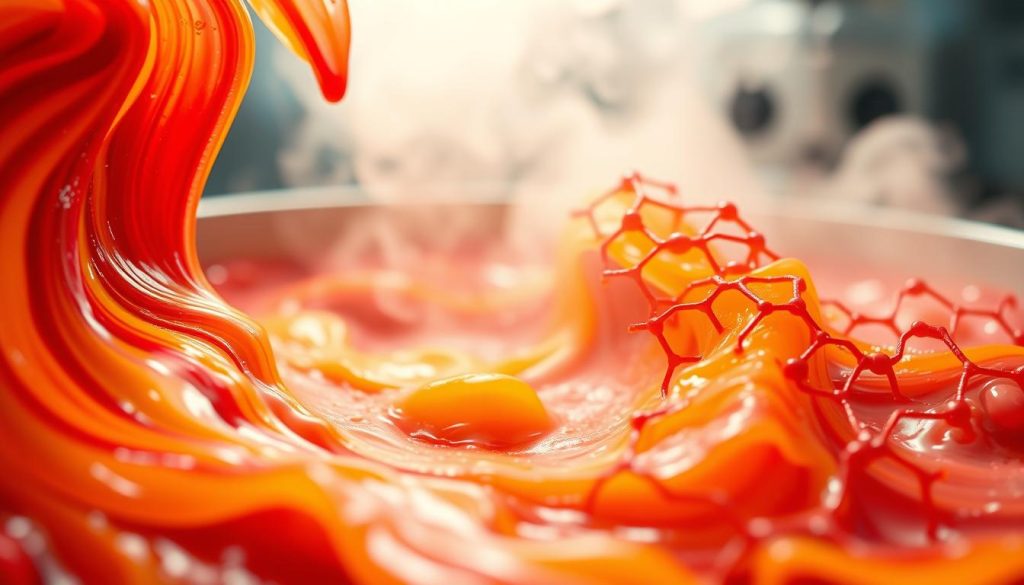
Visual and Textural Indicators of Proper Coagulation
Watch for three critical signs during cooking. Raw meats transition from red to golden-brown as heat reshapes their structures. Custards develop a slight jiggle when egg networks trap liquid perfectly. Overcooked dishes show telltale cracks or dry surfaces from excessive bonding.
Touch becomes your secret weapon. Press chicken breasts to feel resistance—properly set strands offer springiness without hardness. Test baked goods by inserting skewers; clean removal indicates balanced moisture retention.
Scientific Insights from Culinary Experiments
Controlled trials reveal why slow-cooked meats stay tender. Gentle heat allows gradual bonding without squeezing out juices. Contrast this with high-heat methods like rice cooker scrambled eggs, where timing prevents rubberiness by stopping coagulation at optimal stages.
Studies show our brains associate specific textures with safety. The creamy consistency of properly set dairy triggers pleasure responses, while mushy or raw appearances activate caution. This explains why perfectly coagulated dishes feel instinctively satisfying.
Techniques and Applications in Culinary Settings
Ever wondered why professional kitchens achieve flawless textures while home attempts often miss the mark? The answer lies in applying precise methods that guide molecular transformations.
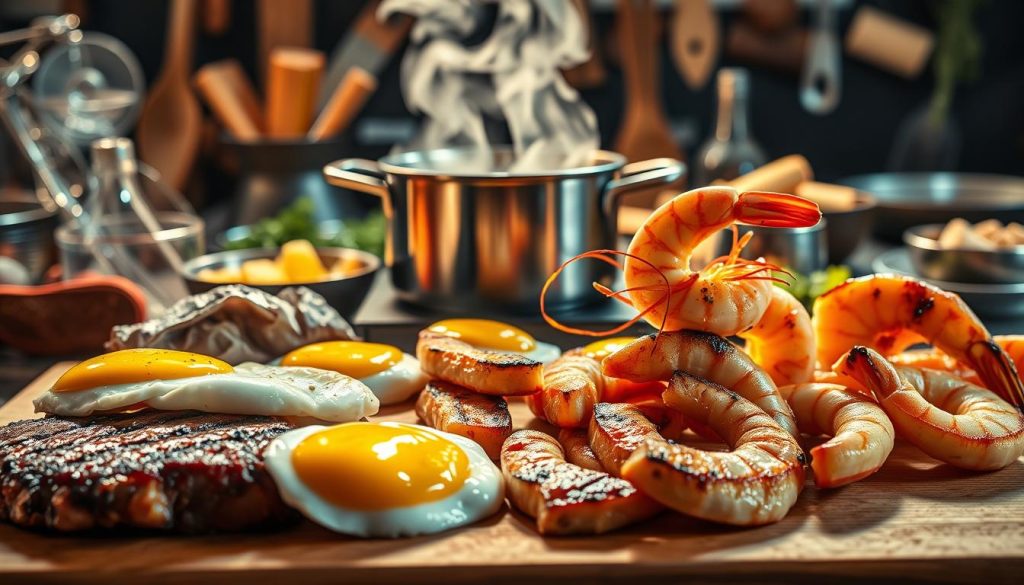
Mastering Delicate Dairy Transformations
Crème brûlée showcases yolk manipulation at its finest. Whipping introduces air while partially loosening strands—mechanical denaturation prepares them for heat’s final act. Gentle oven baking completes the network formation, trapping cream into velvety perfection.
Cheese artisans use similar principles differently. Heating milk begins structural changes, while enzymes like rennet accelerate bonding. This dual approach turns liquid into solid curds—the foundation for countless varieties.
Savory Applications From Pan to Plate
Pan juices tell a story of layered transformations. Roasting breaks down meat components, creating flavorful bases. Simmering concentrates these liquids through gradual bonding—coagulated networks thicken gravies without starch.
Braised dishes reveal time’s impact on texture. Extended cooking at low temperatures softens connective tissues while maintaining moisture. The result? Pull-apart tenderness in pork shoulder or chicken thighs.
For egg enthusiasts, scrambled versions demonstrate speed control. Quick heat application demands constant movement—stopping at the right moment preserves creamy consistency before networks tighten excessively.
Tips for Controlling Protein Coagulation for Optimal Texture
Achieving perfect textures requires more than timing—it demands precision control. Two strategies separate successful results from kitchen mishaps: temperature mastery and ingredient science.
The Low-Heat Advantage
Gentle cooking between 135-155°F (58-68°C) creates ideal conditions. This range lets molecular bonds form gradually. Slow transformations preserve moisture while ensuring safety. Sous vide techniques exemplify this approach, yielding steaks that stay juicy for hours.
“Temperature windows determine whether ingredients sing or scream. Master them, and you control the meal’s destiny.”
Sweet Solutions for Stability
Sugar isn’t just for sweetness—it’s a texture guardian. When heat threatens to shake water molecules loose, sugars act like molecular glue. This bond preservation keeps structures flexible rather than brittle.
| Sugar Type | Moisture Retention | Common Uses |
|---|---|---|
| Sucrose | High | Meringues, custards |
| Trehalose | Very High | Commercial baked goods |
| Glucose | Medium | Sauces, glazes |
Egg white experiments prove this principle. Sugared samples stay transparent under heat, while untreated versions cloud quickly. The difference? Stabilized water networks versus chaotic structural collapse.
Professional kitchens combine these methods. They monitor thermal thresholds while using ingredients that reinforce desired textures. Your turn: Start with scrambled eggs. Add a teaspoon of sugar before cooking. Notice the creamier consistency—your first taste of molecular control.
Conclusion
For millennia, culinary innovation has hinged on a simple truth: altering molecular bonds transforms food at its core. When you apply heat, salt, or acid, you continue a practice older than written history—turning raw ingredients into safe, digestible meals through controlled structural shifts.
Different protein types respond uniquely to these methods. Collagen-rich meat becomes fall-off-the-bone tender through slow thermal breakdown. Delicate egg structures solidify into custards when heated gently. This process isn’t just science—it’s survival wisdom repurposed for modern kitchens.
Your understanding of these reactions elevates everyday cooking. Whether brining chicken for juiciness or crafting silken tofu, you manipulate bonds intentionally. Denatured proteins aren’t accidents—they’re tools for achieving desired textures and flavors.
From ancient preservation to today’s Michelin-starred dishes, controlling molecular networks remains essential. Now equipped with this knowledge, you hold the key to transforming ordinary ingredients into extraordinary food experiences—one carefully managed bond at a time.
